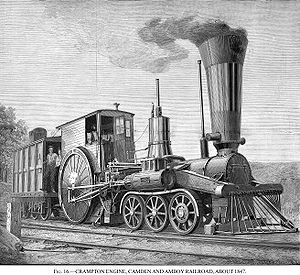
6-2-0
Background to the schools Wikipedia
SOS Children have produced a selection of wikipedia articles for schools since 2005. SOS Child sponsorship is cool!
In the Whyte notation, a 6-2-0 is a railroad steam locomotive that has an unpowered three-axle leading truck followed by a single powered driving axle. This wheel arrangement is often referred to as a Crampton, though that term can refer to some 4-2-0 locomotives as well.
Other equivalent classifications are:
UIC classification: 3A (also known as German classification and Italian classification)
French classification: 310
Turkish classification: 14
Swiss classification: 1/4
History
The 6-2-0 was one of the earlier wheel arrangements that was experimented with in the United States after having proven itself on early English railways.
On a trip to England, Robert L. Stevens, president of the Camden and Amboy (C&A) railroad, saw demonstrations of 6-2-0s on the railways there. When he returned in 1847, Stevens asked his master mechanic Isaac Dripps to build him a 6-2-0 for use on the C&A. The specifications for the first 6-2-0 included a 38" diameter boiler that would burn anthracite coal and 96" diameter driving wheels.
Designing the locomotive type to burn coal, which was still fairly expensive and difficult to come by, was unusual for the time. The great majority of locomotives of the 1830s and 1840s were built to burn wood, which was very plentiful, cheap and exceptionally easy to obtain along the railroad rights of way. Besides being more expensive, coal required a larger firebox in which to burn. Dripps rose to the challenge and created an operable design.
The first locomotive based on these specifications, named John Stevens, was completed in 1849. Dripps wasn't too sure that the locomotive would prove effective on American railroads, and his reservations turned out to be correct. The locomotive's tractive effort was not sufficient for long term or heavy work. With only one driving axle and three unpowered leading axles, too much of the locomotive's weight was spread over the unpowered lead truck. Almost a century passed before a six-wheel leading truck was used again, on the PRR S1 and S2.
The C&A's management, on the other hand, thought it performed admirably enough to order several more of them and place them in passenger service. The 6-2-0s were in use as late as 1865.

